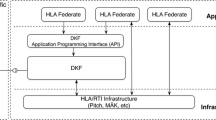Abstract
Although the HLA distributed simulation standard has been widely applied, the RTIs in accordance with the standard usually do not take full account of the reliability of more than 100 HLA services; as a result they cannot be effectively applied to an unreliable network. On the basis of usual management services of HLA, this paper proposes a 6-service compact simulation interface specification (CSIS). Unlike the HLA declaration management based on “class”, CSIS directly deals with data, adopts the data filtering mechanism based on “channel”, and has the same characteristics of interoperability, reusability and scalability as the HLA. In many cases, it can replace the HLA to develop distributed simulations in a simpler way. Aiming at the typical demand of joint simulation between land and offshore systems over unreliable network in various complicated meteorological conditions, YHChannel, an implementation compliant with CSIS, is introduced, which deploys two channel servers in land and offshore respectively. This paper discusses the solution of the reliability of every service in YHChannel, and brings forward a useful communication strategy for unreliable network, which can reduce packet loss rate as well as transmission time by compressing, merging and retransmitting data packets. The experimental results show that when the packet loss rate of an unreliable network is reduced to 20 percent, YHChannel’s packet loss rate will be very small and approximately equal to zero. These ideas about CSIS and the communication strategy in YHChannel can be widely used in the sea-ground-sky-space interconnection between distributed software systems.
Similar content being viewed by others
References
Department of Defense Modeling and Simulation Office. High Level Architecture Rules v1.3. 1998
Department of Defense Modeling and Simulation Office. High Level Architecture Interface Specification v1.3. 1998
Department of Defense Modeling and Simulation Office. High Level Architecture Object Model Template v1.3. 1998
Simulation Interoperability Standards Organization. IEEE Standard for Modeling and Simulation (M&S) High Level Architecture (HLA). IEEE Std 1516-2010, 1516.1-2010, 1516.2-2010. 2010
Balachandran A, Voelker G M, Bahl P. Wireless hotspots: current challenges and future directions. Mobile Netw Appl, 2005, 10: 265–274
Song W. Resource reservation for mobile hotspots in vehicular environments with cellular/WLAN interworking. EURASIP J Wirel Comm, 2012, 2012: 18
Peng S L, Li S S, Liao X K, et al. A scalable code dissemination protocol in heterogeneous wireless sensor networks. Sci China Inf Sci, 2012, 55: 1323–1336
Ding L H, Wu P, Wang H, et al. Lifetime maximization routing with network coding in wireless multihop networks. Sci China Inf Sci, 2013, 56: 022303
Garlington T. Microwave line-of-sight transmission engineering. White Paper No. AMSEL-IE-TS-06015, 2006
Taylor D P, Hartmann P R. Telecommunications by microwave digital radio. IEEE Commun Mag, 1986, 24: 11–16
Ceranowicz A, Torpey M, Helfinstine B, et al. Reflections on building the joint experimental federation. In: Proceedings of the 2002 I/ITSEC Conference, Orlando, 2002
TATA. The Wide Area Network Emulator. TATA Consultancy Services. 2012
Josuttis N M. The C++ Standard Library, 2nd Edition. Boston: Addison-Wesley Professional, 2012. 655–716
Fujimoto R M. Parallel and Distributed Simulation Systems. New York: John Wiley & Sons, 2000
Fujimoto R M. Time management in the high level architecture. Simulation, 1998, 71: 388–400
Liu B, Yao Y, Tao J, et al. Implementation of time management in a runtime infrastructure. In: Proceedings of the 2006 Winter Simulation Conference, Monterey, 2006. 1044–1052
Kuhl F, Weatherly R, Dahmann J. Creating Computer Simulation Systems: An Introduction to the High Level Architecture. New Jersey: Prentice Hall, 1999
Riley G F, Fujimoto R, Ammar M H. Network aware time management and event distribution. In: Proceedings of the 14th Workshop on Parallel and Distributed Simulation, Bologna, 2000. 119–126
Department of Defense Modeling and Simulation Office. RTI 1.3-Next Generation Programmer’s Guide Version 3.2. 2000
Feldspar A. An explanation of the deflate algorithm. 1997
Henning M, Vinoski S. Advanced CORBA Programming with C++. Boston: Addison-Wesley Professional, 1999
Wang H, Wang Y, Tang Y. StarBus+: distributed object middleware practice for internet computing. J Comput Sci Technol, 2005, 20: 542–551
Ziv J, Lempel A. A universal algorithm for sequential data compression. IEEE Trans Inf Theory, 1977, 23: 337–343
Huffman D A. A method for the construction of minimum-redundancy codes. In: Proceedings of the IRE, Berlin: Springer, 1952. 40: 1098–1101
Deutsch L P. DEFLATE Compressed Data Format Specification Version 1.3. RFC 1951. 1996
Fujimoto R M. Lookahead in parallel discrete event simulation. In: Proceedings of the 1988 International Conference on Parallel Processing, Pennsylvania, 1988. 34–41
Lin Y, Lazowska E D. Exploiting lookahead in parallel simulation. IEEE Trans Parallel Distrib Syst, 1990, 1: 457–469
Yang X, Wang Z, Xue J, et al. The reliability wall for exascale supercomputing. IEEE Trans Comput, 2012, 61: 767–779
Author information
Authors and Affiliations
Corresponding author
Rights and permissions
About this article
Cite this article
Liu, B., Wang, H. A novel compact simulation interface specification. Sci. China Inf. Sci. 57, 1–18 (2014). https://doi.org/10.1007/s11432-013-4964-9
Received:
Accepted:
Published:
Issue Date:
DOI: https://doi.org/10.1007/s11432-013-4964-9




